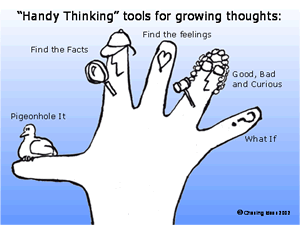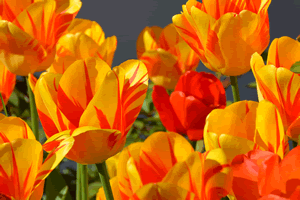 “Knowledge is what you know, wisdom is what you do with what you know.” Anon
“Knowledge is what you know, wisdom is what you do with what you know.” Anon
Learning to think again with a lot of help from my students
Dr. Christine Durham
I didn’t get far (or have much luck) trying to remember my name, who I was, why I was in agony, or where I was – in hospital after an horrific car accident. Many moons later I still didn’t get far or have much luck walking (crawling felt better), talking or even finding my mouth to poke food in it. It was more than a bit scary!
Desperate to find ‘me’ I eventually returned home because surely I’d find ‘me’ at home! But ‘me’ wasn’t at home either; this new ‘me’ couldn’t even find the tap or a fork. More than a bit spooky! Ahah, I thought, ‘me’ must be at school!
Just minutes before the accident that took away my life as I knew it, I’d closed the door on my classroom, thrown my briefcase with nearly completed student reports onto the back seat of the car. I’d just spent time filling the black board with fractions. “We’ll finish the unit on fractions tomorrow if it kills me” I told myself. Little did I realise two more or less fractions on the board would have saved me from my appalling fate!
For many, many moons I felt like I was a child again and, as ‘the experts’ told me again and again that there was no ‘cure’ for brain injury, I had very little hope I’d ever be able to rebuild any sort of worthwhile life.
Being like a child again, childhood memories of Dad’s words came into my empty mind. From the time I was a youngster, whenever I was confronted with a challenge Dad would repeat (ad nauseam, I must admit) “Nil desperandum” (never give up hope). These words were firmly stuck in my head. Additionally, the habit, instilled in me since I was a toddler, was to think things through to find a solution, influenced me to at least try to find a way forward. These two early learnings merged with the epiphany I experienced in ICU, in hospital after the accident.
Returning from the experience of going down the long dark tunnel into the bright light at the end of the tunnel, then finding myself on the ceiling in intensive care, watching a team of medical people work on my body, I had a firm understanding that the most important thing we own are our own thoughts.
Dad’s words, my habit of thinking and this epiphany slowly encouraged me to find ways to find my feet, my mouth and my thoughts, and as time went by my confidence.
Many, many, many, many moons later I’d managed to struggle to get ‘somewhere’ (write books, speak widely, complete a PhD and be awarded Victorian Senior Australian of the Year).
Initially I’d returned to school for a few hours a week taking Philosophy/Thinking workshops with students because I passionately believe in the power of thinking and the strength that comes when we can think for ourselves. Eventually after taking more than 40000 workshops, I wrote “Chasing Ideas” (Finch Publishing) to encourage teachers and parents to help children learn to think for themselves. I’d also written “Doing Up Buttons” (Penguin Books) to help people understand the brain injury experience, and more recently “Unlocking my Brain” (Jane Curry Publishing). I have been invited to speak to a wide range of audiences about coping with Life’s Challenges; and through awards, I hav had the opportunity to be an advocate for brain injury and for teaching students to think.
I’d had amazing results in Philosophy/thinking workshops when I’d used objects as symbols or metaphors for big important issues. Because of my double vision I couldn’t read the philosophy texts, so I searched for objects to be triggers to interest and engage the students and vehicles to carry discussions along allowing students to explore and think for themselves about big important issues.
For example I’d been wracking my brains to broach the subject of ‘ownership’ (as pencils and rubbers were mysteriously disappearing). One day I was waiting at the doctor’s surgery, admiring the brand new carpet, when a mother came in dragging a green face kid. He promptly vomited all over the new carpet. Ahah, now who is going to ‘own’ that! I wondered. The mother certainly thought the receptionist owned it and the receptionist obviously thought the mother owned it!
Vomit became a student friendly and meaningful way to discuss ownership. After telling my students the story I asked them who they though owned the vomit. What fun we had discussing ownership…the kids were busting with ideas and there was much laughter. We used Handy Thinking Tools™ to pull together some of the concepts that had come up – we Pigeonholed ‘ownership’ and asked what was it like? We Found the Facts about ‘ownership’, we Found the Feelings about ‘ownership’, looked at the Good, Bad and Curious things about ownership and finally asked ‘What If?’ to explore different scenarios and their consequences. What a discussion – all brought about by vomit. The kids now had a bunch of understandings and beliefs to look back on and build upon next time an issue came up involving ownership. They’d had practice sharing their own thoughts on the topic. The discussion had built and boosted their confidence in being able to listen to others, judge and make up their own minds, and their ability to properly adapt to the stress of realising not everyone thinks the same and that there are many issues involved in what may seem simple.
It’s important to strike the right note (and not be preachy or prescriptive) in trying to empower students to discover for themselves important qualities that will help them get somewhere on Life’s Journey: to develop wisdom. When students discover advice for themselves, as teachers or parents we have wonderful concepts to revisit and apply to help them when the dog bites and the bee stings.
Discussing something that is fun and interesting, unrelated to what the student may see as ‘instruction’ is a marvellous way to get beneath their skin! I sometimes meet students I’d taught over 20 years ago and without fail they’ll say “I’ll never forget the day when…” It might be the time I threw them a slice of bread and sat eating a slice in front of them. Then we used the Good, Bad and Curious Tool to look at the issue of “What if everyone had to eat a slice of fresh bread every day?” Never have I seen kids dive for their dictionaries with such zest to discover what ‘fresh’ meant – or argue with other over good and bad things that would arise. Of course this was just an example of a rule – and the discussions went through a plethora of issues from crime, punishment, are the rule makers rule breakers, Marie Antoinette and “let them eat cake”….
One morning it was raining cats and dogs as I ran through the rain in front of a soggy bunch of Grade 3 students, flapping behind me with sodden umbrellas. We reached the veranda of the Philosophy room only to discover the door was locked. Whilst two students ran to the office for the key I looked at my dripping bunch and occupied them by playing Simon Says. Once we got settled into our cosy classroom the kids were not ready to settle down to listening to T.H.Jones’ poem ‘Advice to a Knight ….
Wear modest armour; and walk quietly
In woods, whereby any noise is treacherous
Avoid dragons and deceptive maidens…” to start to think about what advice they would give to a child to fit in with the unit they were doing “All about me.”
So I threw my prepared lesson out the window and started where the students were. I asked them to discuss then write some advice to someone playing Simon Says for the first time. After a few minutes we shared some ideas then they started to give me their own ideas that not only fitted advice to someone playing Simon Says for the first time but also was good advice for life.
They demonstrated wisdom as they shared their concepts
“Think for yourself”;
“Don’t jump to conclusions;”
“You can improve by trying hard;”
“You need to be responsible for yourself;
“Enjoy the challenge, challenges are fun.”
A perfect example of positive pupils! They certainly taught me a thing or two about life! These students had learnt to be observant, to listen carefully, to accept challenges, to learn from their mistakes, to use their sense of humour and be confident and resourceful.
Samuel Taylor Coleridge once said that “Common sense in an uncommon degree is what the world calls wisdom”
These students taught me so much as I struggled to ‘get somewhere’. Some of their ‘Pearls of Wisdom’ include:
“I’ve discovered that determination is courage”
“I’ve discovered that you can’t expect people to read your mind.”
“I’ve discovered that other people’s ideas take over your brain.”
“I’ve discovered that mothers know everything.”
“I’ve discovered that if a person underestimates you it’s intelligence not anger that proves your ability.”
“I’ve discovered that your thoughts can control your body.”
“I’ve discovered that you can’t hide all your peas under one spoon.”
As teachers and parents we have a marvellous opportunity to encourage our young people to get somewhere in life, to get wisdom by thinking for themselves.
“We can be knowledgeable with another person’s knowledge, but we cannot be wise with another person’s wisdom.” Michel de Montaigne
Dr. Christine Durham (PhD, MEd) February 2015


